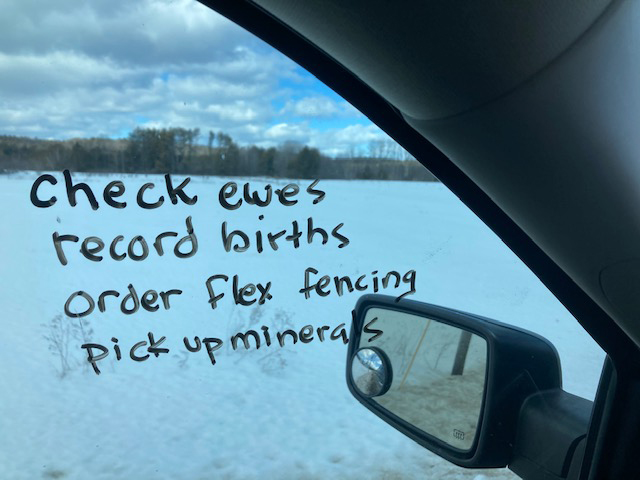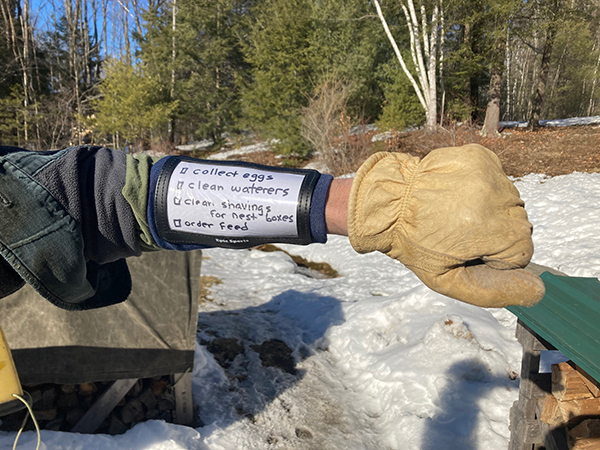Bulletin #1213, Using Checklists to Increase Productivity on the Farm

Using Checklists to Increase Productivity on the Farm (PDF)
By Richard Brzozowski, Maine AgrAbility Project Director, University of Maine Cooperative Extension,
Beatriz M. Rodriguez, Project Director, North Carolina AgrAbility Partnership, and
Rhonda Miller, Ph.D., Project Director, AgrAbility, Utah State University.
Special thanks to N. King, orchardist, Sweden, ME for providing her new employee checklists.
For information about UMaine Extension programs and resources, visit extension.umaine.edu.
Find more of our publications and books at extension.umaine.edu/publications/.
This fact sheet is designed for farmers, ranchers, and workers who want to maximize the use of their time and get peace of mind while enjoying the daily chores at the farm. Checklists can also be helpful for individuals with memory issues or when someone fills in for you or another worker.
Why a Checklist?
The use of a checklist can benefit everyone, including individuals with memory problems, easily distracted individuals, or individuals with cognitive limitations. Using a checklist can help you in many different ways. Think of a checklist as a tool that will help make your work easier. When you know that the checklist is considering all needed tasks in your farm/ranch, you will have one less reason to worry. A checklist will help you keep the workload organized, allowing for better time management and increase efficiency. Managing your time will increase your ability to solve last-minute issues with a fresh mind and the ability to make wise decisions. You can use your checklist to prioritize activities and plan for the next day, including gathering the needed supplies to increase workplace safety. A checklist can also help you stay in compliance with regulatory requirements.
Types of Checklists
Checklists are quick, simple tools to aid in the recall of important information. Most people frequently use a to-do list or a grocery list. Lists help us make sure that we don’t forget something and decrease the mental load needed to remember all of the little details. Checklists can be organized in different ways based upon the type of tasks or activities being completed. Some of the more common types of checklists include:
To-Do Checklists
The daily to-do list is a very common checklist that outlines all the tasks you need to complete in a single day. The tasks will likely change from day to day depending on what’s on the agenda. You may also have checklists for longer periods of time (e.g., weekly, monthly). In most cases, if you don’t finish a task, you can just move it to the next day’s list. Grocery lists and packing lists are other examples of to-do checklists that help ensure items are not forgotten.
Procedural Checklists
Procedural checklists list steps that must be followed in a specific order. They outline the steps, or series of actions, that must be taken to achieve a particular end. Some examples include the steps needed to log into a computer and check your email; or the steps necessary to load and unload grain. The Federal Aviation Administration (FAA) mandates that pilots use a written preflight checklist as they prepare for takeoff. In industry, a Standard Operating Procedure (SOP) is often a procedural checklist. Procedural checklists ensure that critical items are not overlooked.
Project Checklists
A project checklist identifies tasks specific to a particular event or area of your life. Examples include a to-do list for a wedding or before taking a big trip. A producer may consider developing a checklist of items that should be covered when training, or orienting, a new employee. In many cases, these will take longer to complete than a daily to-do list; but, checklists are super helpful for organizing tasks and ensuring that things are completed on time.
Inspection Checklists
Certain settings may require documentation that items are inspected or checked periodically. In agriculture, large dairies may be required to check the water lines daily, and the lagoon levels weekly, as part of a Concentrated Animal Feeding Operation (CAFO) permit. Documentation of the water line inspection and the lagoon level are needed. Verification that all parts of a purchase were received is a form of an inspection checklist. Checklists are extremely useful as a way to verify, and document, that the inspections were completed.
Developing A Checklist
So, what are some ways that a farmer or rancher could develop a checklist? Here are a few tips to consider:
- Think in bite-sized tasks. List them appropriately.
- Think about what needs to be done. Consider the deadlines or schedules related to your work. List each task or item using keywords or as a brief statement. This method is helpful, especially if the list is to be used by more than one person.
- Write the item clearly so it could be easily read and understood by you and others.
- Consider prioritizing the tasks – Ask yourself, “What actions or tasks need attention first?” Stars or specific colors could be used to draw attention to priority items.
- For some farmers and ranchers, a checklist that is built as logical steps or order might prove useful.
- Don’t be afraid to include easy-to-accomplish tasks or actions also known as “low hanging fruit.” These are items or tasks that take relatively little time. The act of accomplishing tasks (crossing off items as “done”) builds confidence, especially for workers with limitations. When you look back at your workday, you can say, “We got a lot done today.”
- Consider nonwork-related items for your checklist. These might include a doctor’s appointment, picking up the kids after school, grocery shopping, etc. By including items such as these on your list, they are less apt to be missed or forgotten.
It is likely that all of your checklist items won’t be accomplished in the time frame you had set. That’s okay. Just figure out a good way to move these to the next day or time period that makes the most sense.
If you work with others or supervise others, consider assigning an entire checklist or just specific tasks to that person. A checklist can be an organized way to assign tasks to specific people. At the start of the day or work period, you might want to discuss tasks on the checklist (including your expectations) so that everything is well understood. Discussing the checklist with the worker provides a good opportunity to let them know about the tools, equipment, or procedures that relate as well as other important details and safety concerns.
Checklist Methods
A checklist kept in your mind is only as good as your memory. Writing down or entering the tasks will help address and accomplish them. Using a checklist is also a good way to recognize what you have done or what needs to be done. A written checklist that is shared can inform others and improve the productivity of others.
Listed below are some different ways you could keep a checklist. Try out a few and settle on the best method for yourself and your situation. More than one method might be needed. When selecting a method, consider the environment in which the checklist will be used. Will there be excess moisture that might interfere with the list? Will freezing temperatures or hot temperatures interfere?
- Whiteboard with a dry erase marker – Whiteboards are relatively inexpensive. They come in different sizes. Some may be attached to a wall, while smaller ones can be carried.
- Pad of paper or hard card (pocket size)
- Chalkboard or clipboard, see figure 1.
- Smartphone – Because most people have a cell phone, it could be an efficient way to keep a checklist in the notes app.
- Electronic mail – Email the checklist to yourself (or others).
- Vehicle window with dry erase marker. Because farmers and ranchers are usually in their truck at some part of the day, keeping a checklist by writing on the driver-side window might prove useful. Erase items (or cross them out) as you accomplish them. See figure 2.
- Hand or arm – If you’ve watched (or played) football, you have likely noticed the quarterback with an adhesive wrap on his/her arm that has the plays listed. This is called a QB sleeve, see figure 3. This same approach could be used on the farm and ranch. You (or a worker) would have the QB sleeve wrapped around the arm for easy access during work. It would likely not be in the way while working. Blank QB sleeves are inexpensive (less than $5).



Summary
Whether you were able to accomplish all tasks on the list or not, look back at the list at the end of the workday. Carry forward items that did not get fully addressed and give yourself a pat on the back or reward the one who got it done. Prioritize your list, use color coding for those time-sensitive activities, use postings to highlight today’s activities. Make sure you take some time for updating needed data or transferring important information required for regulatory items. And, get ready for that positive feeling of accomplishment and give yourself the wow factor.
Maine AgrAbility assists farmers, fishermen, and forest workers to overcome disabilities, injuries, or other barriers so they can continue to work safely and productively in agriculture. This material is supported by a grant from the USDA National Institute of Food and Agriculture (NIFA) under sponsored project number 2018-41590-28715. For more information visit Maine AgrAbility or email maine.agrability@maine.edu.

Information in this publication is provided purely for educational purposes. No responsibility is assumed for any problems associated with the use of products or services mentioned. No endorsement of products or companies is intended, nor is criticism of unnamed products or companies implied.
© 2021
Call 800.287.0274 (in Maine), or 207.581.3188, for information on publications and program offerings from University of Maine Cooperative Extension, or visit extension.umaine.edu.
In complying with the letter and spirit of applicable laws and pursuing its own goals of diversity, the University of Maine System does not discriminate on the grounds of race, color, religion, sex, sexual orientation, transgender status, gender, gender identity or expression, ethnicity, national origin, citizenship status, familial status, ancestry, age, disability physical or mental, genetic information, or veterans or military status in employment, education, and all other programs and activities. The University provides reasonable accommodations to qualified individuals with disabilities upon request. The following person has been designated to handle inquiries regarding non-discrimination policies: Director of Equal Opportunity and Title IX Services, 5713 Chadbourne Hall, Room 412, University of Maine, Orono, ME 04469-5713, 207.581.1226, TTY 711 (Maine Relay System).

